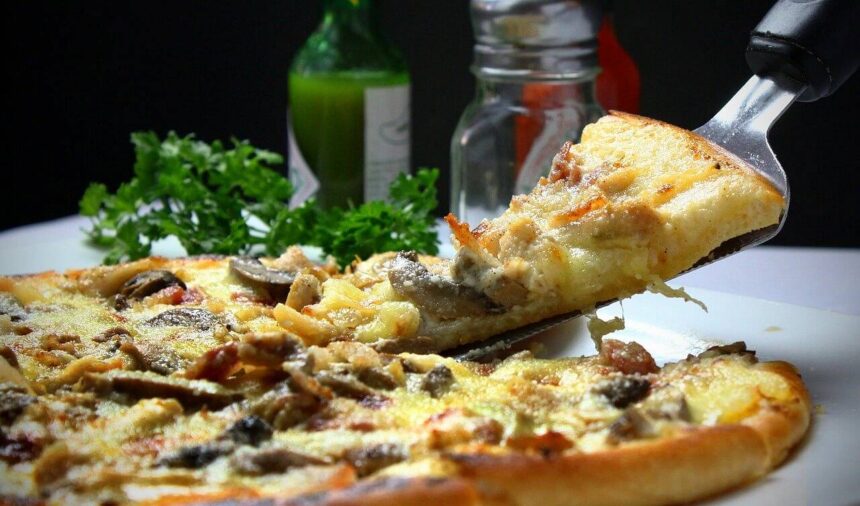There’s a precise moment when golden, crispy cod meets Roman ricotta on the alveolated surface of pinsa. It’s the instant when Trastevere stops being a neighborhood and becomes gastronomic philosophy, when seventy-two hours of fermentation transform into an exportable business model worldwide. The pinsa romana recipe isn’t just a sequence of ingredients but flavor architecture that tells how a product born in 2001 can seem older than the Colosseum, how three apparently incompatible flours generate million-dollar revenue, how the scent of a Roman alley can materialize in any kitchen on the planet.
The hidden alchemy behind apparent simplicity
To understand the pinsa romana recipe in its profound essence, we must start with what isn’t visible. The seventy-two hours of fermentation aren’t romantic waiting but precise biochemical transformation. During this time, at controlled temperature, enzymes degrade complex starches reducing the glycemic index by 30% compared to traditional pizza. Lactic bacteria produce organic acids that lower pH to 4.5, creating an environment hostile to pathogens but favorable for developing complex aromas. Gluten relaxes and reorganizes into more digestible structures.
The three-flour mix – wheat, soy, rice – isn’t chance but gustatory engineering. Wheat provides structure through gluten, soy adds noble proteins increasing nutritional value by 25%, rice facilitates 80% hydration impossible with wheat alone. This formula, jealously guarded by Di Marco, generates a base with 230 calories per 100 grams versus pizza’s 270-300, maintaining superior flavor and satisfaction.
Cod meets DOP ricotta in a marriage that seems improvised but hides iron logic. The fish, desalted for twenty-four hours with water changes every seven, loses 60% of sodium while keeping noble proteins intact. Roman DOP ricotta, with its 11% fat and characteristic sweet note, balances residual saltiness creating what taste neuroscientists call “perfect umami.” It’s not gastronomic folklore but science applied to pleasure.
Surgical precision disguised as spontaneity
Recipe execution reveals how every apparently simple step hides specific technical competencies. Cod desalting requires water temperature between 4 and 8 degrees Celsius: warmer and proteins begin denaturing, colder and salt doesn’t migrate effectively. Changes every seven hours aren’t superstition but optimization of osmotic gradient ensuring uniform sodium extraction.
Sparkling water batter exploits CO2 to create microcavities that, expanding in oil heat, generate crispness persisting even after cooling. The 1:1.2 flour-water ratio is calibrated for 3000 centiPoise viscosity, what kitchen physicists identify as ideal for adherence and browning. Oil at exactly 180 degrees Celsius: five degrees less and cod absorbs fat, five more and exterior burns before interior cooks.
The assembly sequence follows precise thermal logic. First room-temperature ricotta acting as thermal insulator, then still-hot cod releasing steam creating texture contrast, finally EVO oil and lemon zest activating with residual heat liberating aromatic terpenes. Every element has its optimal temperature, its entry moment, its function in the dish’s final architecture.
The business model hidden in a traditional recipe
This apparently simple recipe hides a sophisticated economic model. Food cost hovers around 28%, margin allowing 250-300% markups while maintaining competitive prices. Di Marco certification guarantees consistent base quality, eliminating variables that could compromise results. A restaurateur can serve twenty pinsas per hour with one employee, versus ten pizzas requiring the same labor.
Initial investment for introducing Trastevere pinsa to menus is minimal: pre-cooked bases eliminate need for mixers and fermentation cells, cod can be batch-prepared and stored, DOP ricotta has fifteen-day shelf life. Calculated ROI: investment recovery in forty working days, profitability from month two. Numbers explaining why five thousand pinserias worldwide have adopted this model.
Perceived value exceeds real price. Customers pay not just for ingredients but story, territory, experience. “Trastevere Pinsa” evokes romantic alleys and Tiber sunsets, justifying 30-40% premium pricing versus analogous products. It’s applied neuromarketing: brains associate flavors with emotions, transforming dishes into indelible memories generating loyalty and word-of-mouth.
The total experience transforming customers into ambassadors
Frascati Superiore DOCG isn’t casual suggestion but studied completion. Its 5.5 g/l acidity cuts ricotta’s fattiness, its green apple and almond aromas dialogue with cod’s sweetness, 12% alcohol cleanses palate preparing for next bite. It’s molecular sommellerie transforming meals into complete sensory experiences.
Replicating Trastevere atmosphere anywhere requires profound understanding of what makes that quarter special. It’s not just sampietrini cobblestones or ochre buildings but slow rhythm, conversation prevailing over haste, food as pretext for togetherness. Who serves Trastevere pinsa must create this suspended time, this Roman bubble where customers feel transported regardless of latitude.
The future of territorial recipes plays on this capacity to be simultaneously local and global. Trastevere pinsa can be prepared in Tokyo or New York maintaining authenticity, because authenticity doesn’t lie in ingredients but in method respect, understanding reasons behind every step, ability to transmit not just flavors but culture.
While cod sizzles in boiling oil and ricotta waits patiently on the alveolated base, while lemon perfume prepares to complete the gustatory symphony, it becomes clear this isn’t just a recipe. It’s demonstration that true gastronomic innovation doesn’t invent from nothing but reinterprets intelligently, that commercial success can spring from tradition respect, that Trastevere can materialize wherever someone’s willing to dedicate twenty-four hours to perfect desalting of a piece of cod. And in that dedication, in that patience seeming anachronistic in a world of fast food and ten-minute delivery, lies the secret of a recipe you won’t just love, but that will transform how you think about contemporary
